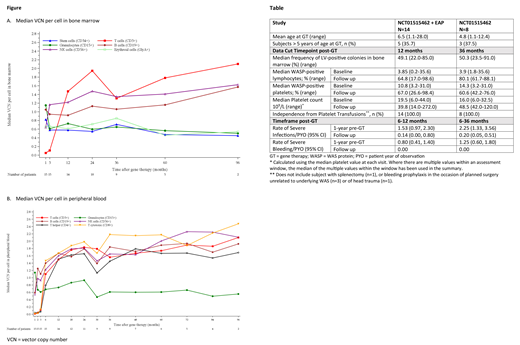Background: Wiskott-Aldrich syndrome (WAS) is a rare, X-linked, life-threatening primary immunodeficiency caused by mutations in the gene encoding the WAS protein (WASP). WASP-deficient immune cells have compromised immunological synapse formation, cell migration and cytotoxicity. Thus, WAS is characterized by development of recurrent or severe infections, eczema, and increased risk of autoimmunity and malignancies. In addition, WASP deficiency results in microthrombocytopenia, leading to severe bleeding episodes. When a suitable donor is available, WAS can be treated by hematopoietic stem cell transplant (HSCT), but HSCT can be impeded by complications such as graft versus host disease, rejection and autoimmunity. Importantly, HSCT may carry higher risks in older children (>2-5 yrs) [Shin et al, 2012; Moratto et al, 2011]. An alternative approach is gene therapy (GT). We previously reported interim results of a Phase I/II clinical trial (NCT01515462) in 8 subjects treated with OTL-103, a drug product composed of autologous CD34+ hematopoietic stem and progenitor cells (HSPCs) transduced ex vivo with a lentiviral vector (LV) encoding human WASP cDNA under the control of the endogenous promoter [Ferrua et al, 2019]. We now report updated results on the safety and efficacy of OTL-103 in 17 subjects treated at San Raffaele Hospital as part of the same clinical trial or expanded access programs (EAP) with up to 8 yrs follow up (FU).
Methods: NCT01515462: As described in Ferrua et al, 8 male subjects (mean age at GT: 4.8 yrs, range 1.1-12.4) were treated with OTL-103. The source of autologous CD34+ HSPCs was bone marrow (BM; n=5), mobilized peripheral blood (mPB; n=2) or both (n=1). As part of a reduced-intensity conditioning regimen, rituximab was given 22 days prior and busulfan + fludarabine during the week before OTL-103 infusion. At time of reporting, all subjects had ≥3 yrs FU (range: 3-8 yrs).
EAP: 9 male subjects (11.2 yrs, 1.4-35.1) received identical treatment to subjects in the clinical trial; autologous CD34+ HSPCs source was mPB in all subjects. At time of reporting, subjects had a median of 1.4 yrs FU (range: 0.1-3.0 yrs) with 6/9 having ≥1 yr FU.
Results: At last FU for all subjects (median: 3.0 yrs, range 0.1-8.0), overall survival was 94% (16/17). One EAP subject died 4.5 mo post-GT, due to deterioration of an underlying neurodegenerative condition considered unrelated to OTL-103 by investigator. To date, there have been no reports of insertional oncogenesis or replication-competent LV. While most subjects experienced adverse events (AEs) due to the reduced-intensity conditioning regimen (mainly mild or moderate), there were no reports of AEs related to OTL-103.
Efficacy endpoints analyses were performed on surviving patients with ≥1 yr FU. Evidence of engraftment of genetically corrected HSPCs and LV+ colonies in BM was observed within 3 mo and persisted up to 8 yrs - the longest published FU of LV vector durability to date (Figure). WASP expression was restored after GT, shown by increases in the fraction of WASP+ lymphocytes and platelets (PLT) within 3 mo and maintained thereafter (Table). After GT, PLT counts improved, leading to a reduction of frequency and severity of bleeding events. Independence from PLT transfusions and absence of severe bleeding events were observed in all subjects by 9 mo FU (Table). Immune function improved; all evaluable patients discontinued immunoglobulin supplementation after GT (median time to discontinuation: 0.9 years after GT, range: 0.2-5 years). Furthermore, reduction in severe infection rate was observed post-GT, suggestive of immune reconstitution (Table). The decrease in bleeding events and severe infection rates occurred despite the integration of subjects into normal daily activities. Eczema progressively resolved or was reduced compared to baseline.
Conclusions: This combined analysis of 17 subjects treated in a clinical trial or EAP with up to 8 yrs FU demonstrates that GT continues to be an effective treatment for WAS. All surviving subjects achieved high levels of multilineage engraftment, sustained restoration of WASP expression in lymphocytes and PLTs, improved PLT counts, and fewer bleeding events. A significant reduction in severe infection rate suggests reconstitution of immune function. Importantly, clinical benefit was also attained in older subjects (>5 yrs), a group considered at higher risk when treated with allogeneic HSCT.
Jones:Orchard Therapeutics: Employment, Equity Ownership. Dott:Orchard Therapeutics: Employment, Equity Ownership. Naldini:Genenta Science: Consultancy, Equity Ownership; Magenta Therapeutics: Equity Ownership; San Raffaele Telethon Institute for Gene Therapy (SR-TIGET), a joint venture between Fondazione Telethon and Ospedale San Raffaele (OSR): Other: Wiskott-Aldrich Syndrome (WAS) gene therapy was licensed to GlaxoSmithKline (GSK) in 2014. It was then licensed to Orchard Therapeutics (OTL) in April 2018. OTL is the current sponsor of the clinical trial.. Aiuti:San Raffaele Telethon Institute for Gene Therapy (SR-TIGET), a joint venture between Fondazione Telethon and Ospedale San Raffaele (OSR): Other: Wiskott-Aldrich Syndrome (WAS) gene therapy was licensed to GlaxoSmithKline (GSK) in 2014. It was than licensed to Orchard Therapeutics (OTL) in April 2018. OTL is the current sponsor of the clinical trial.; San Raffaele Telethon Institute for Gene Therapy (SR-TIGET), a joint venture between Fondazione Telethon and Ospedale San Raffaele (OSR): Other: Study PI.
Author notes
Asterisk with author names denotes non-ASH members.


This feature is available to Subscribers Only
Sign In or Create an Account Close Modal